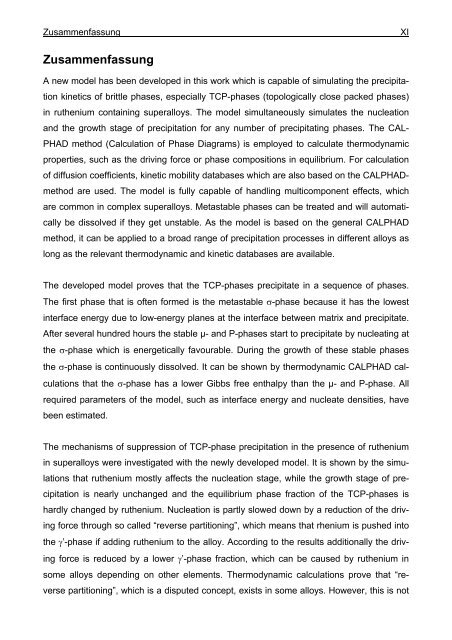Mathematische Modellierung der Ausscheidung ... - OPUS-Datenbank
Mathematische Modellierung der Ausscheidung ... - OPUS-Datenbank
Mathematische Modellierung der Ausscheidung ... - OPUS-Datenbank
Sie wollen auch ein ePaper? Erhöhen Sie die Reichweite Ihrer Titel.
YUMPU macht aus Druck-PDFs automatisch weboptimierte ePaper, die Google liebt.
Zusammenfassung XI<br />
Zusammenfassung<br />
A new model has been developed in this work which is capable of simulating the precipita-<br />
tion kinetics of brittle phases, especially TCP-phases (topologically close packed phases)<br />
in ruthenium containing superalloys. The model simultaneously simulates the nucleation<br />
and the growth stage of precipitation for any number of precipitating phases. The CAL-<br />
PHAD method (Calculation of Phase Diagrams) is employed to calculate thermodynamic<br />
properties, such as the driving force or phase compositions in equilibrium. For calculation<br />
of diffusion coefficients, kinetic mobility databases which are also based on the CALPHADmethod<br />
are used. The model is fully capable of handling multicomponent effects, which<br />
are common in complex superalloys. Metastable phases can be treated and will automatically<br />
be dissolved if they get unstable. As the model is based on the general CALPHAD<br />
method, it can be applied to a broad range of precipitation processes in different alloys as<br />
long as the relevant thermodynamic and kinetic databases are available.<br />
The developed model proves that the TCP-phases precipitate in a sequence of phases.<br />
The first phase that is often formed is the metastable σ-phase because it has the lowest<br />
interface energy due to low-energy planes at the interface between matrix and precipitate.<br />
After several hundred hours the stable µ- and P-phases start to precipitate by nucleating at<br />
the σ-phase which is energetically favourable. During the growth of these stable phases<br />
the σ-phase is continuously dissolved. It can be shown by thermodynamic CALPHAD cal-<br />
culations that the σ-phase has a lower Gibbs free enthalpy than the µ- and P-phase. All<br />
required parameters of the model, such as interface energy and nucleate densities, have<br />
been estimated.<br />
The mechanisms of suppression of TCP-phase precipitation in the presence of ruthenium<br />
in superalloys were investigated with the newly developed model. It is shown by the simulations<br />
that ruthenium mostly affects the nucleation stage, while the growth stage of precipitation<br />
is nearly unchanged and the equilibrium phase fraction of the TCP-phases is<br />
hardly changed by ruthenium. Nucleation is partly slowed down by a reduction of the driving<br />
force through so called “reverse partitioning”, which means that rhenium is pushed into<br />
the γ’-phase if adding ruthenium to the alloy. According to the results additionally the driv-<br />
ing force is reduced by a lower γ’-phase fraction, which can be caused by ruthenium in<br />
some alloys depending on other elements. Thermodynamic calculations prove that “reverse<br />
partitioning”, which is a disputed concept, exists in some alloys. However, this is not

















